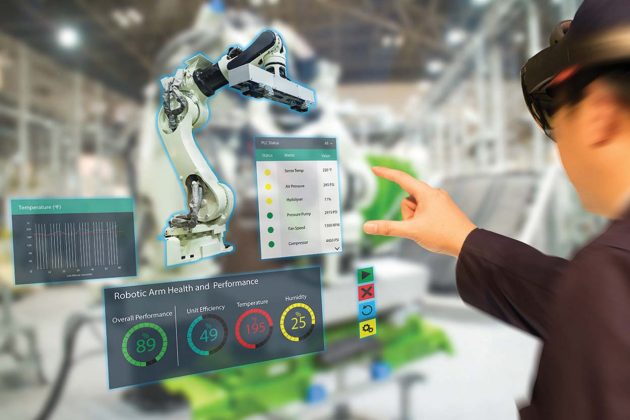
Smarter factory: Putting digital technology to work in your plant
By Scott Hale
Innovation & Technology Electronics Manufacturing advanced manufacturing digitalization digitization IIoT Industry 4.0 IoT manufacturing sensors smart factoryHow digitization and networked systems power maintenance and warehousing.

An engineer using smart glasses with virtual reality technology to monitor machinery in real time. PHOTO: Monopoly919 – stock.adobe.com
Sensors, cloud-based networks, and seamless information sharing are changing the way manufacturers work. These technologies and connecting ecosystems are hallmarks of Industry 4.0. Leading manufacturers are turning their attention from traditional, linear business operations to interconnected, open systems that unleash the power of data.
Smart maintenance shows Industry 4.0 in action. It falls into two categories: predictive and remote. The proliferation of sensors and the Internet of Things (IoT) has really opened the door for both of these approaches.
Predictive maintenance has the potential to truly disrupt traditional, reactive maintenance. Imagine your company has several plants. All of the manufacturing equipment has been outfitted with sensors that gather data about the health of the machines. The sensor data is then sent to a cloud-based system and is accessed by employees in any location.
Maintenance teams proactively analyze the information to identify failure-related patterns. For instance, it may be that every time a factory completes a run of 4,000 parts, the machinery bearings and bushings need to be replaced. Based on this information, the maintenance team may decide to proactively replace parts before starting an order that requires a high-volume run of parts. This minimizes the likelihood the machine will break down in the middle of an order, saving money and ensuring deadlines are met.
A Fortune 500 manufacturer that implemented a predictive maintenance program has equipped several machines with sensors. An interface sends data to Autodesk’s Inventor design system whenever the machine registers an error. The maintenance team monitors position and orientation data from the equipment, uses it for issue tracking, and initiates design modifications to the machine, where needed.
Remote maintenance is another way manufacturers use technology to respond more rapidly to plant problems and minimize downtime. In addition to the collection of error code data, the information is used to automatically submit maintenance requests to a cloud server that’s accessed by teams remotely. Repair teams are immediately dispatched. Because sensors are working 24/7, equipment failures are identified immediately. In addition, cloud-based management systems mean the head of maintenance no longer has to be physically located in the factory with the equipment.
Customers with tight deadlines appreciate working with manufacturing partners who proactively monitor their factory equipment health and are confident that they’ll deliver products on time. In addition, lower factory downtime translates into higher levels of productivity and higher profit margins.
Working with customers
Smart warehousing and inventory management also help manufacturers work more closely with customers. Take for example, a communications company that tracks and aggregates combined bill of materials (BOM) requirements data for multiple projects to ensure proper warehousing and availability for all locations.
A custom application was built to allow project managers for each location to push the electronic BOM information for their project to the cloud. That data automatically populates and updates the manufacturer’s inventory and asset management systems.
As a result, adequate components in inventory for that location’s order are immediately reserved.
This means shorter lead times for the project. It also translates into better visibility for inventory planners. Carrying less inventory reduces expenses, so it’s a win for all.
Sensors embedded in warehouse lighting fixtures, as well as heating and cooling systems, gather valuable information about energy use.
There’s also a potential benefit. That data combined with information from warehouse motion sensors could be used to deploy more efficient lighting, heating, and cooling strategies. For instance, if one area of a warehouse is not used during specific times of the day or week, lighting and temperature levels are adjusted accordingly.
Augmented reality is another 4.0 technology applied to the warehouse. It combines virtual model data of machinery, products or renovation plan with data captured from the existing environment. The facility is captured through photogrammetry or 3D scanning. The augmented view is then created digitally and combined with the virtual model to convey how a new factory layout would work in the available space.
Many building renovation projects begin with this approach because it provides a cost effective way to mitigate risk and highlight construction and warehouse reconfiguration issues earlier in the process. Digital annotations also help locate manufactured products within the warehouse environment. Workers outfitted with augmented reality glasses identify pick points in the warehouse to quickly find products.
Industry 4.0 is changing the game for manufacturers. The combination of sensors, cloud data storage and cloud-based software solutions has opened the door for new opportunities to reduce costs, increase productivity and boost customer satisfaction.
Scott Hale is vice-president of consulting services, IMAGINiT Technologies, a specialist in technology and software development with offices across Canada. Visit www.imaginit.com.
This article originally appeared in PLANT Magazine’s May-June 2020 print issue.
